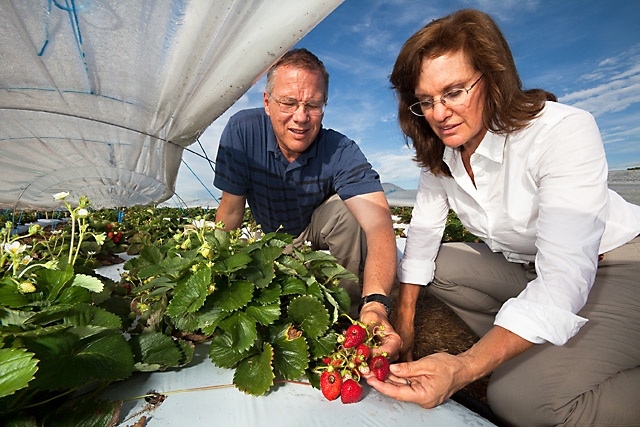
Features
Fruit
Production
Research examines extending strawberry season
October 24, 2012 By USDA-ARS
 ARS geneticist Kim Lewers and ARS horticulturist John Enns are testing the idea of growing strawberries under low row covers to extend the berry's growing season. USDA-ARS
ARS geneticist Kim Lewers and ARS horticulturist John Enns are testing the idea of growing strawberries under low row covers to extend the berry's growing season. USDA-ARSOctober 24, 2012 – Growing strawberry plants beneath low tunnels can allow the season to start earlier and continue through the summer and fall, according to U.S. Department of Agriculture (USDA) scientists.
At the Agricultural Research Service (ARS) Genetic Improvement of Fruits and Vegetables Laboratory in Beltsville, Md., geneticist Kim Lewers is testing several strawberry cultivars in the new production system designed to extend the growing season in the northern and eastern United States. Lewers’ research partners are horticulturist John Enns and support services staffer George Meyers.
Low tunnels are canopies made of long sheets of plastic laid over support hoops that hold it about 30 inches above the strawberry bed. Strawberries are planted beneath these structures, which protect the fruit from rain, provide shade from damaging infrared and UV light, and can capture warmth during the cooler spring and fall seasons.
By protecting the plants from rain, the tunnels help to minimize two important diseases of strawberry, Botrytis and anthracnose, which thrive in the rain. Botrytis occurs in cool, wet conditions, while anthracnose takes hold in hot, wet conditions.
According to Lewers, growers also use high tunnels but they can be problematic because the humidity is higher in the tunnel, which causes more Botrytis and more powdery mildew, another strawberry disease. But in low tunnels, the humidity is the same as outside the tunnel when the sides of the tunnel are up.
Maryland’s peak strawberry season is usually mid-May to mid-June, but in Lewers’ low-tunnel production system, strawberries start earlier and continue through the fall – essentially a whole new season. In some months, yields in the low tunnels can be as high as those from the same cultivars when they are grown in California, where they were developed.
All of the strawberry plant material developed in Lewers’ research program has been and still is freely available. The plants are not patented, so they are available without special license to any nursery that wants to grow them.
Read more about this and other fruit and vegetable research in the October 2012 issue of Agricultural Research magazine.
Print this page